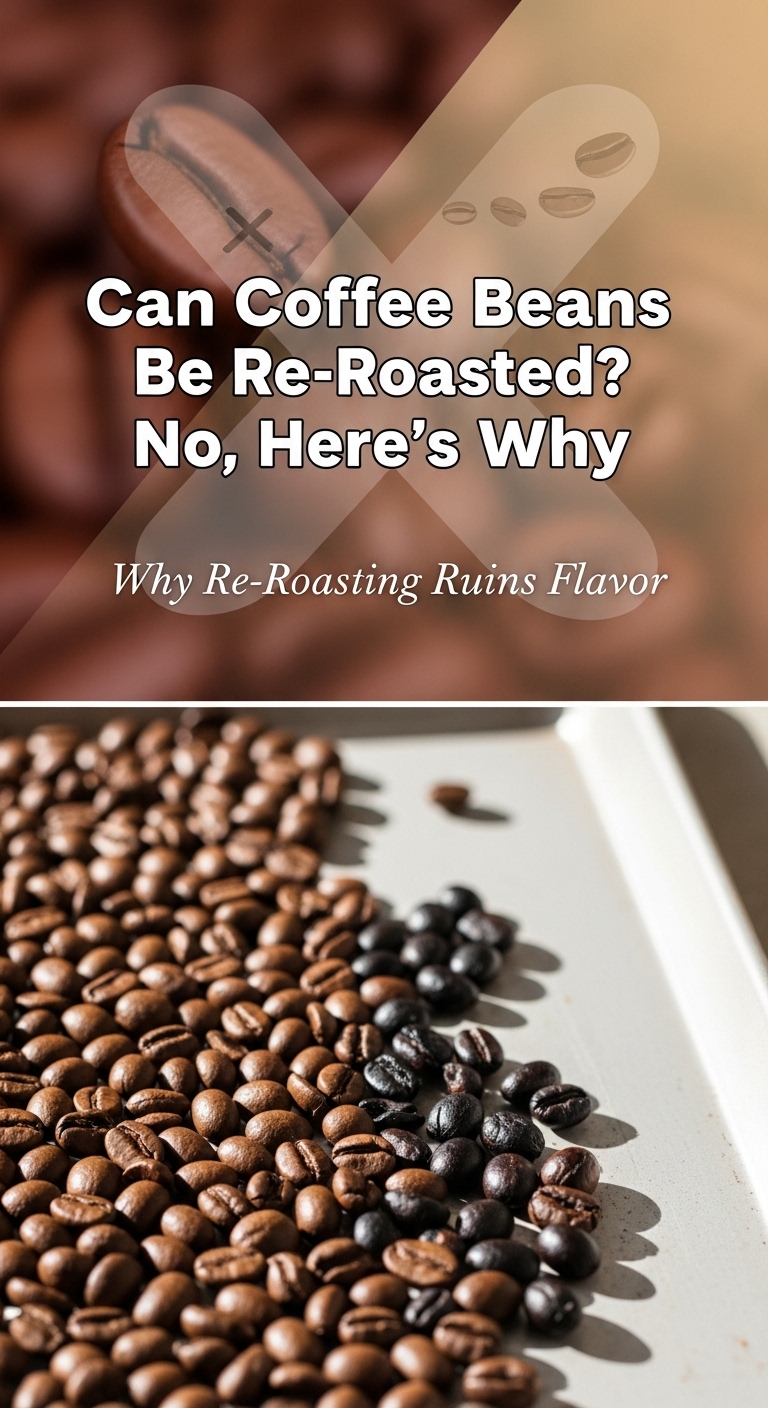As an Amazon Associate CoffeeXplore.com earns from qualifying purchases.
Can Coffee Beans Be Re-Roasted? No, Here’s Why
Have you ever finished a home roast only to find the coffee beans are lighter than you’d like, or maybe a bit too sour? The immediate thought is often, “Can I just put them back in the roaster and fix it?” This guide definitively answers that question, unpacking the science behind why a second roast doesn’t work and what you can do instead.
No, re-roasting coffee beans is not recommended. The process fundamentally cooks the beans rather than developing new flavors, leading to a burnt taste, loss of aroma, and an overall reduction in quality. This is because the initial roast causes irreversible chemical and physical changes that cannot be replicated.
Leveraging extensive analysis of professional consensus and the science of coffee chemistry, this guide unpacks the critical insights you need. We’ll explore exactly what happens during that crucial first roast, why trying to repeat it fails, and provide proven, practical alternatives to salvage your beans and avoid wasting a good batch.
Key Facts
- Expert Consensus is Clear: The overwhelming agreement among coffee professionals is that you should not re-roast coffee beans, as it leads to a burnt taste and significant loss of quality.
- Moisture is the Missing Ingredient: Green coffee beans contain 12-15% moisture, which is essential for flavor development. Roasted beans have only 1.5-3% moisture, making a second roast chemically unviable.
- Chemical Changes are Irreversible: The initial roast consumes the sugars and amino acids needed for the Maillard reaction and caramelization, the two core processes that create coffee’s complex flavors.
- Flavor Destruction is Inevitable: Instead of developing new notes, re-roasting simply cooks the beans, creating undesirable flavors like leather, earth, ash, and resin while destroying the delicate aromas.
- Blending is a Better Solution: A far more effective way to salvage under-roasted beans is to blend them with a darker roast, such as a French roast, in a 1:4 ratio to balance the flavor profile.
The Short Answer: Why Re-Roasting Coffee Beans is a Bad Idea
No, re-roasting coffee beans is not recommended. The process fundamentally cooks the beans rather than developing new flavors, leading to a burnt taste, loss of aroma, and an overall reduction in quality. This isn’t just an opinion; it’s the firm consensus among coffee experts, grounded in the unchangeable chemistry of a roasted coffee bean.

Once a bean has gone through the intense heat and chemical transformation of its first roast, it is fundamentally a different object. The key ingredients for flavor creation—moisture, sugars, and specific amino acids—have been consumed or radically altered. Attempting to apply high heat a second time is more akin to burning toast than it is to perfecting a roast.
The consensus among coffee professionals is that re-roasting can lead to a burnt taste, loss of aroma, and an overall reduction in flavor quality. It’s a bad idea to try roasting beans that have already cooled from the initial roast.
But why exactly does this happen? To understand, we need to look at the science of the first roast.
The Science of the First Roast: What Re-roasting Can’t Replicate
The initial roast causes irreversible chemical changes like the Maillard reaction and caramelization, which depend on the bean’s original moisture, sugars, and amino acids. These components are consumed or fundamentally altered, making a second roast chemically impossible to replicate. A coffee bean’s journey from a raw, green seed to a fragrant, brittle bean is a one-way trip filled with complex transformations.
Did you know a green coffee bean loses most of its moisture in the first few minutes of roasting? That initial water content is a key ingredient that’s missing the second time around. Here are the key stages:
- Moisture Evaporation: Green beans start with about 12-15% moisture. The first phase of roasting is essentially a drying stage, where this water turns to steam, creating the pressure that will later be essential.
- The Maillard Reaction: Around 300°F, the magic begins. This is a crucial chemical reaction between amino acids and sugars that creates hundreds of different aroma and flavor compounds. It’s the same reaction that gives browned bread and seared steak their delicious flavor.
- Caramelization: As temperatures rise to about 370°F, the bean’s natural sugars begin to caramelize. This process breaks down larger sugars into smaller ones, developing the deeper, sweeter, and more complex notes we associate with coffee.
- First Crack: At roughly 400°F, the built-up pressure from steam and carbon dioxide causes the bean to audibly crack and physically expand. This marks the transition to a light roast and is a critical milestone where the bean’s structure changes permanently.
- Pyrolysis: Beyond the first crack, the process of Pyrolysis takes over. This is the thermal decomposition of organic compounds. Sugars and acids break down further, oils migrate to the surface, and the dark, carbon-y notes of a dark roast develop.
Each of these steps relies on the bean’s original chemical makeup. Once that’s been used, it’s gone for good.
### The Critical Role of Moisture Content
Green beans have 12-15% moisture, which acts as a medium for flavor development; roasted beans have only 1.5-3%, preventing the necessary chemical reactions from occurring again. This massive loss of water is the single biggest reason re-roasting fails. Moisture is not just a passive component; it’s the medium in which heat is transferred through the bean, facilitating the even progression of the Maillard reaction and caramelization. Without it, you get uneven heating and scorching.
| Feature | Green Coffee Bean | Roasted Coffee Bean |
|---|---|---|
| Moisture Content | 12-15% | 1.5-3% |
| Chemical State | Raw, unreacted sugars and amino acids | Consumed or transformed compounds |
Think of it like trying to bake a cake twice. The ingredients have already transformed!
### Flavor Development vs. Flavor Destruction
The first roast uses the Maillard reaction and caramelization to build complex flavors. Re-roasting lacks the necessary precursors and instead burns the remaining compounds, destroying the coffee’s aroma and taste. The process is a tale of two opposite outcomes.
- First Roast (Development):
- Maillard Reaction: Creates hundreds of new, volatile flavor and aroma compounds that give coffee its signature character.
- Caramelization: Develops the deep, rich sweetness and pleasant bitterness by transforming natural sugars.
- Second Roast (Destruction):
- Lacks Precursors: The sugars and amino acids needed for the above reactions are gone.
- Burns Existing Compounds: Applying more heat simply chars the delicate compounds created during the first roast, leading to ashy, flat, and burnt flavors.
- Destroys Aroma: The volatile aromatic compounds, which are responsible for that wonderful coffee smell, are quickly driven off by the second round of heat.
What Really Happens When You Re-Roast Coffee? The Undesirable Outcomes
Re-roasting coffee results in “cooking” the beans, creating burnt and ashy flavors, destroying volatile aromas, and causing unevenness due to the lack of moisture and altered chemical state. The fragile structure of roasted beans also makes them prone to defects. While you might hope to “fix” an under-roasted batch, you’re far more likely to make it completely undrinkable.
Pro Tip: Instead of risking an entire batch, if you must experiment, try it with only a handful of beans to see the disappointing results for yourself without wasting the whole bag.
Here are the specific negative consequences you can expect:
- – Burnt, Baked Flavors: This is the most common outcome. Without the moisture and chemical precursors for a true roast, the heat simply bakes and then burns the beans. This creates unpleasant, one-dimensional flavors often described as ashy, resinous, or like burnt carbon.
- – Loss of Aroma: The beautiful, complex aromas of coffee are created by volatile organic compounds. Re-applying intense heat quickly drives these compounds away, leaving you with beans that smell like smoke or char rather than coffee.
- – Uneven Results: Roasted beans are dry and brittle. They don’t transfer heat evenly like dense, moist green beans do. This leads to scorching on the outside while the inside remains unchanged, resulting in roasting defects like “tipping” (burnt ends) and “facing” (scorched flat sides).
- – Fragile Structure: The porous, expanded structure of a roasted bean is fragile. The agitation and heat of a second roast can cause them to chip, crack, or shatter, creating an inconsistent grind and poor extraction.

Smarter Alternatives: How to Salvage Under-Roasted or Unwanted Coffee
Instead of re-roasting, fix under-roasted or unwanted coffee by blending it with a darker roast (e.g., a 1:4 ratio with French roast), donating it to a local non-profit, or using it for cold brew where its acidity might be less pronounced. Since you can’t go back in time with your roast, the best approach is to work with what you have. These methods are far more effective and won’t risk destroying your entire batch.
- Blending: Mix your light or sour beans with a much darker, more developed roast.
- Donation: If the roast profile simply isn’t for you, consider donating it.
- Cold Brew: The slow, cold extraction process of cold brew can mellow out the sharp acidity often found in under-roasted beans.
- Double Roasting: This is a niche, expert-level technique, not a simple fix (more on this below).
Have you ever tried blending beans to balance a roast? Share your favorite combinations in the comments!
### The Blending Solution
Blend your lighter, under-roasted beans with a darker roast, such as a French roast, starting with a 1:4 ratio to balance the flavor profile and reduce sourness. This is the single most effective way to make your beans more palatable. The robust, smoky, and chocolatey notes of a dark roast can mask the unwanted sourness and grassy flavors of an under-developed bean.
- Choose a Contrasting Bean: Pick a dark, oily bean like a French or Italian roast.
- Start with a 1:4 Ratio: For every one part of your under-roasted coffee, add four parts of the dark roast.
- Grind Together: Grind the beans together to ensure they are thoroughly mixed for an even extraction.
- Taste and Adjust: Brew a cup and see how it tastes. If it’s still too sour, increase the proportion of the dark roast.
### The “Double Roasting” Exception: A Niche Technique for Experts
Double roasting is a niche technique for skilled roasters to turn a recent (under 4 months old) light roast into a dark roast, but it is not a reliable method for fixing old or poorly roasted coffee. It’s crucial to understand this is not the same as casually re-roasting a bad batch. It’s an intentional process with very specific requirements.
Double roasting is an experimental technique applied by some professionals for specific flavor outcomes. It is not recommended for home users trying to salvage a failed roast, as it requires precise control and specific conditions to avoid defects.
This technique might be considered only under these strict conditions:
* High-Quality Arabica Beans: The beans must be of high quality to begin with.
* Initial Light-to-Medium Roast: The process starts with a properly executed, but intentionally light, roast.
* Freshly Roasted: The beans must be relatively fresh, typically within four months of the first roast, to retain enough structure and compounds.

If you’re looking to get the perfect roast from the start, investing in a quality home coffee roaster gives you the control you need to dial in the exact flavor profile you love, avoiding the need for risky fixes.
FAQs About can coffee beans be re roasted
### Can I re-roast coffee beans to make them darker?
While you can technically make the beans physically darker by applying more heat, you are not truly “roasting” them. You are burning the already-developed compounds, resulting in a dark but ashy, burnt-tasting coffee with no desirable flavor, aroma, or complexity. The change is purely cosmetic and detrimental to the taste.
### Will re-roasting fix under-roasted or sour coffee?
Re-roasting may make under-roasted coffee less sour, but it does so by burning off compounds, not by properly developing flavor. The result is often a flat, less flavorful, and slightly burnt coffee that trades one bad characteristic (sourness) for another (ashiness). Blending with a darker roast is a much better alternative for balancing flavor.
### Can you restore stale coffee beans by re-roasting them?
No, stale coffee beans cannot be restored. The flavor is gone because the volatile aromatic compounds have dissipated over time due to oxygen exposure. These compounds are what give coffee its life and aroma. Re-roasting cannot bring them back and will only make the old, lifeless beans taste even worse by adding a burnt flavor.
### What’s the difference between re-roasting and double roasting?
Re-roasting is generally an attempt to fix a flawed, old, or unwanted roast, which doesn’t work because the necessary chemical precursors are gone. Double roasting is a specific, intentional technique used by some professionals on fresh, high-quality light roasts to transform them into dark roasts for a particular flavor profile. It’s an expert method, not a salvage operation.
Final Summary: Embrace the Roast You Have
The science and professional consensus are clear: attempting to re-roast coffee beans is a futile effort that will almost certainly ruin them. The irreversible chemical and physical changes from the first roast mean the potential for positive flavor development is gone, leaving only the potential for a burnt, ashy taste. The best path forward is to accept the roast you have and use smarter strategies to make the most of it.
- The Chemistry is Final: Once roasted, the bean’s moisture and chemical precursors for flavor are gone. You cannot recreate the Maillard reaction or caramelization.
- You’ll Burn, Not Roast: A second heating session cooks and burns the beans, destroying delicate aromas and creating flat, unpleasant flavors.
- Blending is Your Best Bet: The most effective way to salvage under-roasted coffee is to blend it with a darker roast to balance the flavor profile.
- Focus on the Next Batch: Learn from the experience to improve your technique for the next time you roast.
Instead of trying to fix the past, use these tips to make the most of your current beans and perfect your next roast
Last update on 2025-12-15 / Affiliate links / Images from Amazon Product Advertising API

